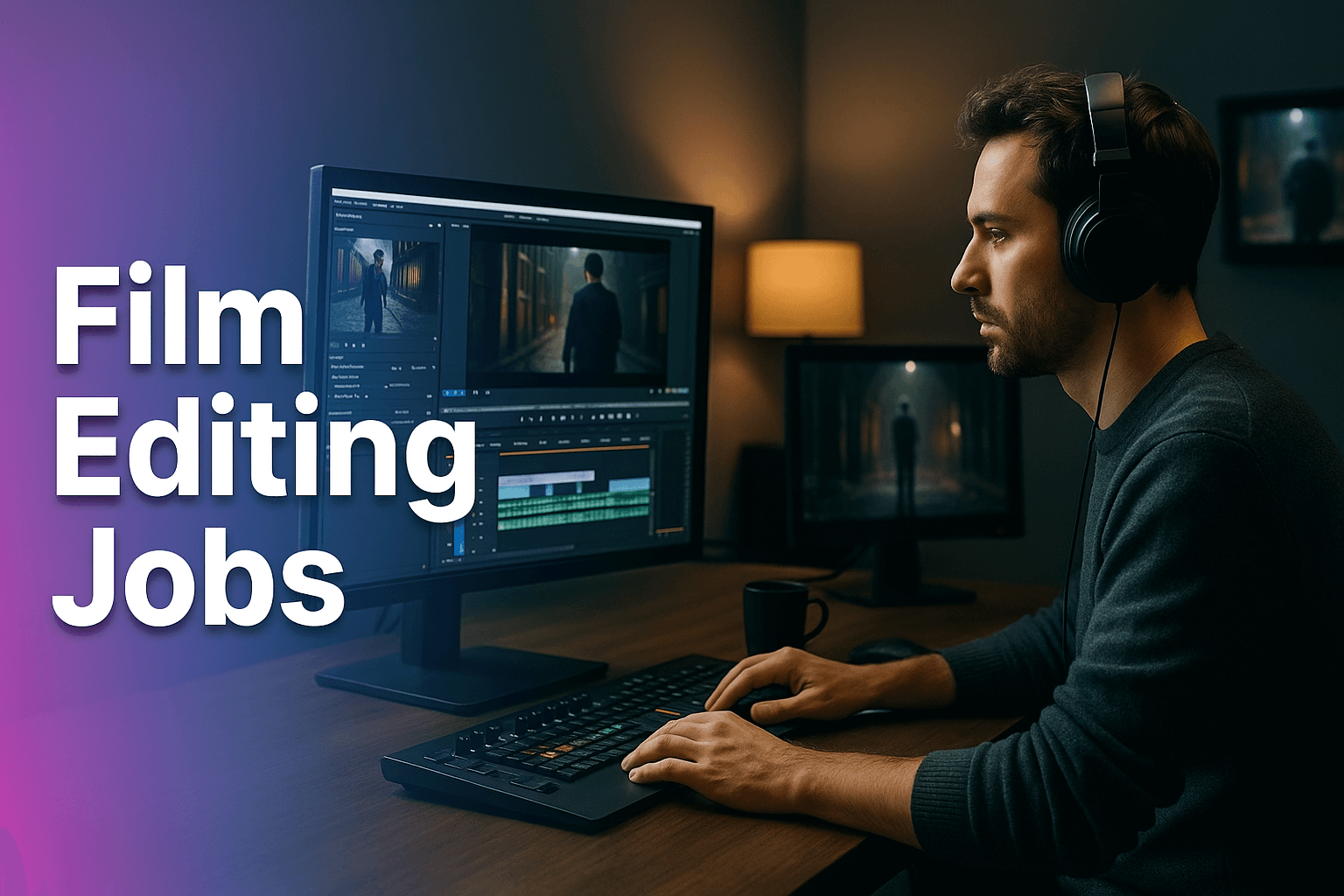Film Editing Jobs: Navigating the Modern Media Landscape

Introduction
As a strategist observing the media and entertainment (M&E) ecosystem, I can attest that the role of a film editor has evolved beyond the traditional confines of a physical editing suite. Today, a film editing job is no longer a purely technical function but a core creative and strategic role.
The modern editor must possess a comprehensive understanding of storytelling, technology, and the fragmented global M&E supply chain. The question for many aspiring professionals and veteran executives alike is how to find a foothold and thrive in this increasingly complex and competitive landscape. This article provides a comprehensive overview of the realities, skills, and strategic considerations required to build a successful career in film editing.
Key Takeaways
| Core Challenge | The film editing industry is highly fragmented, making it difficult to find quality projects and forge strategic, long-term partnerships. |
| Strategic Solution | Adopt a data-driven approach to career management by identifying collaborators, tracking project lifecycles, and building a professional network. |
| Vitrina’s Role | Vitrina provides real-time project tracking and verified executive contacts to help editors discover new opportunities and build their careers. |
The Evolving Role of the Film Editor
I have observed that the creative output of an editor is now directly tied to a project’s commercial success. From a strategic perspective, an editor is a partner in the post-production process, entrusted with bringing a director’s vision to life while also understanding the nuances of target audience consumption.
The technical skills are a baseline requirement, but the true value lies in a keen sense of pacing, narrative structure, and an ability to manage complex assets. According to an analysis from the U.S. Bureau of Labor Statistics, the demand for film and video editors is projected to grow faster than the average for all occupations, with a particular focus on digital media platforms. This growth is driven by the explosive proliferation of streaming services and the constant need for new, compelling content.
From a technical standpoint, the editor is at the center of a complex workflow. They must be proficient in industry-standard software like Adobe Premiere Pro, Avid Media Composer, or DaVinci Resolve, but also adept at managing terabytes of raw footage, collaborating with sound designers and colorists, and ensuring seamless delivery to multiple distribution channels.
This requires not only technical precision but also a high degree of organizational skill and the ability to work under tight deadlines. The rise of remote work has further complicated this, as editors must now be able to coordinate with teams scattered across the globe, often in different time zones.
The Economic Realities of a Film Editing Job
When I analyze the financial side of a film editing job, I see a landscape defined by two primary models: salaried employment and freelance work. Full-time positions at studios or post-production houses offer stability, benefits, and a clear career path. However, the majority of the market, particularly in the digital space, operates on a project-by-project freelance basis.
According to a 2024 Upwork report, freelance video editors can earn anywhere from $10 to $150+ per hour, with rates varying dramatically based on experience, location, and the project’s complexity. Simple social media clips are on the lower end, while high-end commercials or feature films command premium rates.
The key challenge for a freelance professional is managing a pipeline of work. The traditional methods of networking—word of mouth, attending industry events, and referrals—are still vital, but they are often not enough to sustain a consistent flow of high-value projects. The constant need to discover new clients and projects, vet their credibility, and manage complex contracts is a full-time job in itself.
The lack of a centralized, real-time source of project intelligence means editors often miss out on early-stage opportunities before they are widely publicized, or they spend an inordinate amount of time on low-value scouting. This is where a data-driven approach becomes indispensable.
The New Currency: Global Visibility and Connections
In my assessment, the most valuable asset for a modern film editor is not their technical skill alone, but their visibility within the global M&E supply chain. As projects become more international and collaborative, an editor’s ability to connect with producers, directors, and financiers across continents is a significant competitive advantage. This is where the old model of networking hits a wall; it is simply not feasible to manually track every studio, production company, and executive around the world.
A strategic approach to finding a film editing job involves moving beyond passive job boards and taking a proactive role in business development. This means identifying projects in the development or pre-production phase, understanding who the key decision-makers are, and reaching out with a targeted, value-driven pitch.
This requires access to verified, real-time data that provides an early warning on what projects are in the pipeline. It requires a system that can connect a specific genre, budget, and stage of production to the right contact person. Without this, an editor is left to rely on chance and reputation alone.
How Vitrina Helps in a Film Editing Job Search
From my strategic perspective, Vitrina is a powerful solution for professionals seeking a competitive edge in a film editing job market. The platform’s core capabilities directly address the major pain points I’ve outlined:
- Project Tracking: Vitrina’s real-time project tracker gives you an early warning on thousands of film and TV projects as they move through the supply chain. This means you can identify projects in the development or production stage and reach out to decision-makers before the post-production team is even assembled.
- Executive & Person Search: The platform contains a database of over 3 million verified M&E executives and crew-heads, tagged by their department, specialization, and with verified contact details. This allows you to bypass gatekeepers and connect directly with the people who need your specific skills.
- Company Profiling: Vitrina’s extensive company profiles provide detailed information on studios, streamers, and vendors, including their recent projects and deal track record. This intelligence helps you vet potential clients and partners, ensuring you pursue high-quality, relevant opportunities.
Conclusion
While the fundamental creative skills required for a film editing job remain constant, the strategic approach to building a career has shifted. The days of relying solely on a reel and professional reputation are being replaced by the need for data-driven intelligence and a proactive business development mindset. The modern film editor must be an astute market observer, a skilled collaborator, and an active networker.
The professionals who will thrive are those who embrace this change and leverage tools that provide them with an unfair advantage. By having access to a single source of truth for project and company data, they can move with confidence and precision. This strategic shift from reactive job-seeking to proactive opportunity creation is not just a trend; it is the new standard for success in the global M&E industry.
Frequently Asked Questions
A film editor is a professional who assembles raw footage into a cohesive and compelling final product. They work closely with directors to ensure the story is told effectively, making critical decisions on shot selection, pacing, and narrative flow. Their work goes beyond technical cuts, shaping the final look and feel of a movie, TV show, or other video content.
According to the U.S. Bureau of Labor Statistics, the median annual wage for film and video editors was $78,410 in May 2023. However, this figure can vary significantly. Freelance editors may charge an hourly rate ranging from $10 for entry-level work to over $150 for high-end projects, with earnings highly dependent on experience, location, and the type of project.
While a formal degree in film, media studies, or a related field can provide a strong foundation, it is not a strict requirement. The career path for a film editor relies more on a strong portfolio of work, practical skills, and professional experience. Many successful editors began by working on short films, documentaries, or freelance projects to build their reel and network.
A successful film editor requires a blend of technical and creative skills. Technical proficiency in editing software like Avid, Premiere Pro, and DaVinci Resolve is essential. However, it is equally important to possess a keen sense of storytelling, attention to detail, strong problem-solving skills, and the ability to work collaboratively with a director to achieve a shared creative vision.

























